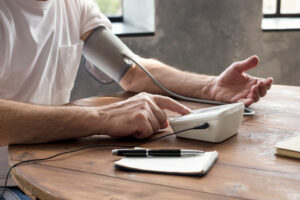If you’re reading this on a phone or laptop, take a moment to notice your posture. Is your head tilted forward? Are your shoulders slumped? If so, you might be familiar with the nagging ache known as “tech neck.” This modern malady, caused by repeatedly looking down at screens, is becoming increasingly common. This article explains how to deal with tech neck and offers effective tech neck pain management strategies. We will explore simple adjustments and exercises you can do to find relief and prevent the pain from coming back, so you can enjoy your devices without discomfort. Visit the best Pain Management Clinic in Brooklyn at Doral Health & Wellness or log on to www.doralhw.org to schedule an appointment with us.
What Is Tech Neck and Why Does It Happen?
Tech neck is not a formal medical diagnosis, but a term used to describe the stress injury and pain in the neck, upper back, and shoulders caused by poor posture when using electronic devices. The human head weighs about 10 to 12 pounds. However, as you tilt your head forward to look at a screen, the effective weight on your cervical spine increases dramatically.
- At a 15-degree angle, the strain is about 27 pounds.
- At a 30-degree angle, it increases to 40 pounds.
- At a 60-degree angle, it’s a staggering 60 pounds of pressure on your neck.
This constant forward head posture overstretches the muscles in the back of your neck and upper back while shortening the muscles in the front of your neck and chest. Over time, this imbalance can lead to chronic pain, stiffness, headaches, and even nerve-related issues like numbness or tingling in your arms and hands.
How to Deal with Tech Neck: Effective Strategies
The best approach to managing tech neck involves a combination of improving your ergonomics, incorporating regular movement, and performing targeted exercises. These tech neck pain management strategies can provide significant relief.
- Adjust Your Ergonomics
Creating a more posture-friendly environment is the first line of defense.
- Raise Your Screen: Position your monitor or screen at eye level. For a laptop, this might mean using a separate keyboard and mouse with a laptop stand. For a phone or tablet, hold the device closer to your face instead of looking down.
- Use a Supportive Chair: Your chair should support the natural curve of your spine. Ensure your feet are flat on the floor and your back is resting against the backrest.
- Take Frequent Breaks: Set a timer to remind yourself to get up, stretch, and walk around every 30 to 60 minutes. The 20-20-20 rule is also helpful: every 20 minutes, look at something 20 feet away for 20 seconds to rest your eyes and reset your posture.
- Incorporate Stretches and Exercises
Simple movements can counteract the strain of forward head posture. Try to perform these stretches several times throughout the day.
- Chin Tucks: Sit or stand up straight. Gently tuck your chin toward your neck, as if you’re making a double chin. Hold for 5 seconds and repeat 10 times. This helps strengthen the muscles in the front of your neck.
- Chest Stretch: Stand in a doorway and place your forearms on the frame, with your elbows slightly below shoulder height. Step forward with one foot until you feel a gentle stretch across your chest. Hold for 30 seconds.
- Upper Trapezius Stretch: Gently tilt your head to one side as if trying to touch your ear to your shoulder. Use your hand to apply light pressure for a deeper stretch. Hold for 30 seconds on each side.
When Home Remedies Aren’t Enough
For many people, these lifestyle adjustments and exercises are enough to alleviate tech neck pain. However, if your pain is severe, persistent, or accompanied by symptoms like numbness, weakness, or radiating pain, it’s time to seek professional help.
A pain management specialist can provide a thorough evaluation to rule out more serious underlying conditions and develop a personalized treatment plan. They have a deep understanding of the musculoskeletal system and can offer more advanced therapies. Your treatment plan might include:
- Physical Therapy: A physical therapist can guide you through specific exercises to correct muscle imbalances and improve posture.
- Manual Therapy: Techniques like massage or myofascial release can help relieve muscle tension and improve mobility.
- Injections: In some cases, a pain management specialist might recommend trigger point injections or nerve blocks to provide targeted pain relief.
For those in New York, finding a qualified pain management clinic in Brooklyn can be a crucial step toward recovery. The experts at a specialized pain management clinic in Brooklyn can offer a comprehensive approach to diagnosing and treating your neck pain, helping you find lasting relief.
Tech neck might be a product of our modern world, but it doesn’t have to be a permanent condition. By being mindful of your posture, making simple ergonomic changes, and seeking professional help when needed, you can effectively manage the pain and get back to using technology comfortably. Visit the Doral Health & Wellness Pain Relief Department in Brooklyn, to get professional help and guidance on how to manage your problem. Call us on + 1-718-367-2555 to get a consultation. If you need help learning coping methods, register your information and make direct contact with our doctors at https://yuz88hfiyh7.typeform.com/Doralintake. Log on to www.doralhw.org. Or visit us at 1797 Pitkin Avenue, Brooklyn, NY 11212.






